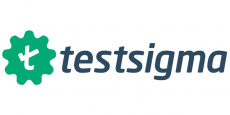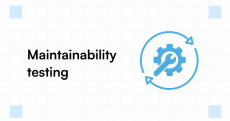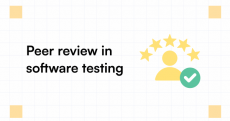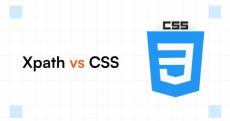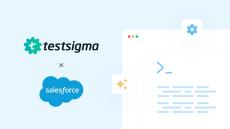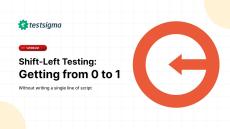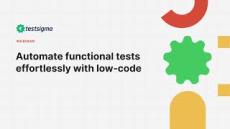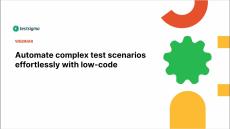Let’s say a developer introduced some changes and 2 days later the team observes that a feature does not work partially. This feature is not related to this developer’s change. However, since it was working fine a day later, all the changes may be reviewed by the manager. The conversation may start with the manager asking a question such as, “Did your changes regress?” To which the developer might agree after analysis or go into debugging mode.
|
By Roman Shvydun
Continuous testing is a key part of DevOps. It makes sure that software products are released with the best quality. In this blog post, we will talk about how to get started with a continuous testing strategy for DevOps projects. That way you can make sure your development process runs smoothly and efficiently.
In the realm of software development, testing plays a pivotal role in ensuring the quality and reliability of desktop applications. As desktop applications become more sophisticated and complex, manual testing alone is no longer sufficient to meet the demands of efficiency and accuracy. This is where desktop automation tools for testing come into play.
|
By Kiruthika Devaraj
In the software biz, we must test a product like absurd before putting it out to the world. There are different levels of testing, from functional to acceptance, and each one checks specific things to make sure everything’s up to par. Check out this blog to learn more about why each level matters.
The DevOps life cycle is a comprehensive approach that combines development and operations practices to streamline and optimize the software delivery process. It encompasses various phases, including planning, coding, testing, deployment, monitoring, and feedback. By integrating these traditionally separate disciplines, DevOps promotes collaboration, agility, and continuous improvement, allowing organizations to deliver high-quality software more efficiently and effectively.
|
By Ritika Kumari
All software undergoes continuous modifications. Sometimes developers do so to fulfill clients’ requests, and other times it is to upgrade the functionality or security features. But whatever the case, any changes made to the software require continuous monitoring and maintenance. Testing software for how maintainable it is, is called Maintainability testing. Let’s dive deeper into the subject in this blog. We will also talk about automated testing with maintainability testing.
|
By Ritika Kumari
Reviewing your work is critical in the software development life cycle (SDLC). It reduces the instances of human errors and allows for better-quality code. Similarly, peer review in important, that involves peers checking each other’s work. But why is it essential, and how much software quality does it improve? Let’s see.
|
By Bharath Krishna
As a software project ends, every tester must check the effectiveness of the testing process to gain insights into the areas of improvement. So, QAs create a Test Closure Report. It includes all the test data, such as test cases, test plans, test suites, and other testing-related information for future reference. With this report, the test insights are recovered, making reviewing the testing process easier and identifying improvement areas in future projects.
Nowadays, ‘Quality’ is becoming a crucial factor in software delivery, where continuous improvements are happening to improve the quality in order to keep the customers happy. However, how often have we seen risk based testing as part of a testing strategy or something that teams religiously do every sprint, during regression testing or any exploratory testing?
|
By Priyanka
Modern web automation is changing, and new automation tools are emerging into the market. New tools provide a bundle of features for End-to-End Testing, API Testing, and Component testing. Interestingly some of the tools even started utilizing Artificial intelligence and codeless automation. Most of the automation shares one important thing which is the locator.
|
By Testsigma
In this video, we explain how you can create a test case and add tests to automate a sample scenario in the Salesforce application in just a few simple steps! Do not hesitate to reach us at support@testsigma.com or drop your message in the chat!
|
By Testsigma
We all know about the importance of automatically deploying applications to production, but do we know how to build a fully automated quality control system that continuously provides feedback on the application's state and determines whether it is ready for production rollout based on quality metrics? Watch for Alex Pshe, SDET at JetBrains share her step-by-step algorithm!
|
By Testsigma
The pressure for faster releases and higher quality has been a constant in the QA realm. Data-driven testing steps in to efficiently execute diverse test scenarios with varying data inputs, improving the coverage and speeding up testing cycles.
|
By Testsigma
Automating functional tests helps verify application behaviour from a user’s perspective. However, given the complexity of modern-day functional tests, automating them using scripts adds a massive layer of ambiguity, creates enormous technological overhead and makes it difficult to maintain and scale tests across platforms. In this session, we discuss how to automate functional tests without writing ambiguous frameworks.
|
By Testsigma
A webinar with Akshay Maldhure for actionable insights on integrating automated testing, prioritizing best practices, and overcoming challenges in your CI/CD processes.
|
By Testsigma
Join our product experts as we discuss how to automate complex test cases across platforms without having to write and maintain ambiguous scripts.
|
By Testsigma
In this webinar our experts walk you through why building a mobile-centric test automation strategy is important, the hurdles in conventional framework-based mobile automation systems and how to build a mobile-first test automation strategy using Testsigma's low-code approach.#testautomation #mobile #low-code #testing.
|
By Testsigma
Our product experts discuss on the growing problem of user fragmentation, the pitfalls of browser incompatibility and how to build a scalable low-code cross-browser testing strategy using Testsigma.
|
By Testsigma
A round-up of all the Testsigma updates that were rolled out in June. These updates help you scale up your automation testing process better.
- April 2024 (3)
- February 2024 (1)
- January 2024 (1)
- December 2023 (2)
- October 2023 (1)
- September 2023 (1)
- July 2023 (3)
- June 2023 (17)
- May 2023 (24)
- April 2023 (36)
- March 2023 (24)
- February 2023 (24)
- January 2023 (46)
- December 2022 (25)
- November 2022 (25)
- October 2022 (13)
- September 2022 (17)
- August 2022 (8)
- July 2022 (14)
- June 2022 (19)
- May 2022 (6)
- April 2022 (4)
- March 2022 (4)
- February 2022 (5)
- January 2022 (5)
- December 2021 (1)
- November 2021 (4)
- October 2021 (3)
- September 2021 (14)
- August 2021 (9)
- July 2021 (13)
- June 2021 (14)
- May 2021 (13)
- April 2021 (9)
- March 2021 (5)
- February 2021 (12)
- January 2021 (9)
- December 2020 (13)
- November 2020 (2)
- October 2020 (4)
- September 2020 (1)
- August 2020 (4)
- July 2020 (4)
- June 2020 (3)
- May 2020 (7)
- April 2020 (5)
- March 2020 (5)
- February 2020 (5)
- January 2020 (5)
- December 2019 (5)
- November 2019 (1)
- May 2019 (1)
- April 2019 (1)
- March 2019 (1)
- November 2018 (1)
- July 2018 (1)
- May 2018 (10)
- April 2018 (1)
Unified continuous testing tool to automate end-to-end testing for web, mobile apps & APIs.
Testsigma lets everyone including SMEs and QAs write automated tests at least 5X faster using simple English and intuitive interface. Reuse existing step groups. Write Selenium and JS based custom functions to extend Testsigma to your custom requirements. Near zero initial time, cost and resources required. No tool setup or ramp-up delay! Testsigma is a cloud-based Test Automation Ecosystem with all the essential elements required for test automation.
AI-driven continuous testing platform for continuous delivery:
- Fully loaded Test Lab on the cloud to run tests: Inbuilt test lab on the cloud with 1000+ OS/Browser/Version combos and 2000+ real mobile devices to run thousands of tests in minutes. Create and run Test Suites across different browsers, versions, operating systems, and devices. Run tests on Real Device Cloud with a range of physical Android and iOS mobile devices. Test internal applications on your local devices.
- AI to reduce Maintenance efforts & improve Productivity: Dynamic Locator Strategy that saves test maintenance time by 70%. Identifies affected tests and potential failures upfront to save execution time & cost. Saves time and effort required in manually identifying the affected tests when the application changes. Creates a test plan automatically based on past result trends.
- Scalable Test Lab on the cloud for Parallel Test Executions to save Time & Cost: Run thousands of tests in minutes in parallel for faster feedback. Parallel Test Executions to reduce regression testing time from weeks to minutes. Scalable Test Lab on cloud with thousands of test devices/machines to run your tests in parallel for faster feedback in Agile and DevOps.
- Continuous Testing, CI/CD support for Agile and DevOps Teams: Shift-Left approach, CI/CD integration, and fast feedback to accelerate the delivery of web & mobile apps. Built for Continuous Testing with a Shift-Left approach to start automation testing right form your design phase.
Sign up for free and get started with test automation on the cloud within minutes!





